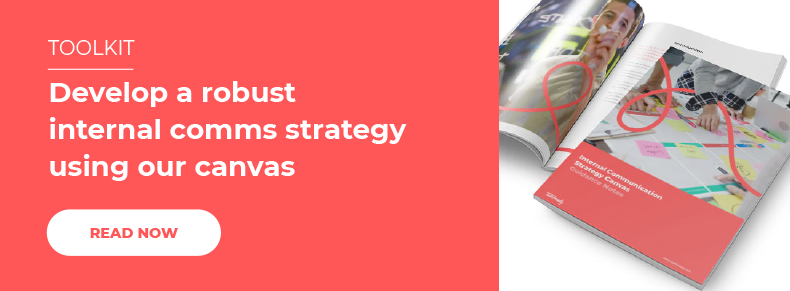What’s the first thing that comes to mind when you hear the term ‘internal communications’? An email from the boss? A date for the staff party? An update on the expenses procedure? Internal communications includes all these elements, and many more. It’s a broad term that covers many areas of business. As such, there are many internal communication types that need to take place within an organisation. While one of the traditional internal communication examples is a memo from the boss, the truth is that this is just one small part of the bigger picture. Internal communication comprises many varieties of exchanges between leadership, departments, teams and colleagues, covering a wide range of topics and issues.
In this blog, we take an in-depth look at the seven fundamental types of internal communications and how best to apply them in your internal communication strategy. With the right tactics, you can make each internal communication stream work harder for your business.
- Leader-to-employee
- Employee-to-leader
- Employee-to-employee
- Information delivery
- Culture communication
- Change management
- Crisis management
Types of internal communication
#1 Leader-to-employee
This is the classic ‘email from the boss’ type of messaging. It’s the flow of information from the top down, from leaders to employees on the office floor. Also known as ‘downward communication’, it is the traditional method often viewed as the core role of internal communications. Once upon a time, this was the only method of internal communication that took place. Now, it’s just one of many streams we use to communicate with employees.
Downward Communication Examples:
- Formal announcements
- Progress reports
- Corporate overviews
- Business updates
- Management messaging
Objectives:
Leadership-generated communications tend to be both formal and company-wide in nature. They are focused on informing staff of the overall business direction and strategy. In addition, their function is to make leaders visible, especially in larger organisations where some employees may never meet senior management in person. This is especially relevant in the hybrid working environment, helping to connect remote employees with the broader company vision.
Channels:
Email is one of the most widely used internal communication channels for leader-to-employee messaging. However, this may not be the most effective way to reach all employees, with email overload becoming a real issue in most offices. Company-wide meetings are an excellent way to increase leadership visibility but can mean that remote workers miss out on important announcements.
Try this:
Consider putting a face to the name with a video message from the CEO. This will ensure that your leaders are both seen and heard. Gallup research indicates that hearing directly from the boss positively affects engagement levels, helping staff feel a sense of purpose in their work. With the rise of video conferencing, employees are more primed than ever to connect via screens rather than in person. It’s a great way to connect with all employees, even the hard-to-reach.
#2 Employee-to-leader
This is about giving your employees a voice. It encompasses all communications that travel from employees to managers and others higher up in the company hierarchy. Known as ‘upward communication’, of all the different types of internal communication, this one is overlooked at your peril. It’s one of the internal communication best practices that deliver real results.
Upward Communication Examples:
- Discussion forums
- Workplace pulse surveys
- Virtual suggestion boxes
- Staff polls & votes
- Employee survey
Objectives:
Your aim is not to talk at your employees, but to talk with them. Employee-to-leader communications should give everyone in your organisation a voice, regardless of role, seniority or location. Communicating with employees is a two-way process, ensuring every worker plays an active role in contributing to the company. Giving your employees a feedback channel lies at the heart of effective internal communication.
Channels:
When you’re aiming to improve internal communication, opening up two-way communication channels is the best place to start. Keep your finger on the pulse of your company’s health with regular feedback opportunities. By carrying out frequent internal communication surveys, you will ensure that employees have a chance to be heard. You’ll find employees jump at the opportunity to speak out. And, by opening up your channels across the company, you’ll find you start hearing from remote workers as well as the more vocal office-based employees.
Try this:
It’s vital to monitor the engagement levels of your workforce by scheduling regular surveys, polls and health checks. Consider using an internal communication app to help you timetable and deliver your check-ups. Built-in feedback modules make it easy to create a range of polls and surveys and evaluate your responses. Keep up a regular stream of feedback requests, and you’ll find you have a motivated, engaged workforce who feel their opinion matters.
#3 Employee-to-employee
When employees talk with each other, great things start to happen. As well as organising communications between employees and management, it’s also essential to connect employees with each other. Also known as ‘lateral communication’ conversations between employees need to be actively encouraged and facilitated in order to be effective.
Lateral Communication Examples:
- Social media spaces
- Communication hubs
- Peer recognition schemes
- Project collaboration
- Team events (virtual or in-person)
Objectives:
Encouraging collaboration between employees is one of the key types of communication in business. When employees share with their peers, the benefits of internal communication quickly become apparent. Your aim is to prompt conversations that support company culture, improve problem-solving, generate new ideas and strengthen camaraderie and morale. With the advent of video conferencing and internal communication apps, it’s now easier than ever to connect teams, wherever they’re based.
Channels:
Employee communication on a lateral level can be facilitated on a range of different channels. Social media networks are fantastic for encouraging the informal sharing of knowledge and opinions. However, they do need to be carefully monitored and controlled. Project collaborations can be handled via traditional email and face-to-face meetings, or moved on to an internal communication platform for greater reach. Internal communication trends are moving towards the app as a solution for improving peer-to-peer connections.
Try this:
Considering creating a social space where employees can meet, chat and share information and knowledge. It will keep business operations front of mind and help encourage a shared commitment to company goals. Employee engagement platforms offer conversation modules that allow you to hold dedicated group conversations, using social tools such as likes, follows and comments to promote interaction.
#4 Information delivery
What do new starters need to know? Is everyone aware of the latest policies? Do employees understand how to use the systems? The delivery of information is a core element of the internal communications process. It is the role of the internal communications department to ensure that every employee is fully informed on all organisational, legal and procedural issues. It may be one of the less exciting types of internal communications, but it is essential to the company's success.
Information Delivery Examples:
- Legal requirements
- Brand positioning
- HR policies and procedures
- Training tools
- Onboarding processes
Objectives:
Information is power. Armed with knowledge and understanding, employees will offer an improved service for clients and an improved performance for the business. Understanding is crucial. One of the common internal communication mistakes is delivering information without a strategy to determine whether it has been correctly understood. Effective communication in the workplace relies on monitoring the impact of communications, not just whether they’ve been received.
Channels:
An employee intranet can be an ideal vehicle for streamlining information and ensuring it is all kept in one secure place. However, it does need careful management. One of the reasons intranets fail to engage employees is that they are allowed to become outdated. As soon as information can no longer be relied on as current, the intranet instantly loses traction. Your internal communication tools must be up-to-date, or they’ll quickly gather dust.
Try this:
Consider gathering your information into a central hub on an internal communication app. The app will allow you to post knowledge, documents, videos and more into a single accessible area. By enabling employees to access the platform via their favourite device, you’ll be breaking down barriers and connecting with every employee. Even the hard-to-reach.
#5 Culture communication
It’s intangible, but hugely influential. Company culture affects everything from hiring and retaining staff to brand positioning, business stability and financial performance. And, of course, employee engagement levels. A strong company culture will be felt not only by employees, but clients who come into contact with it. It’s the platform on which your success will be built.
Culture Communication Examples:
- Mission statements
- Corporate social responsibility (CSR)
- Rewards and recognition schemes
- Social media announcements
- Company values messaging
Objectives:
Your aim is to introduce a sense of purpose into your organisation. Purpose-driven organisations have been shown to outperform those that are purely profit-driven. Research from the Federal Reserve Bank of New York revealed that 78% of CEOs believe culture is one of the top five drivers for an organisation. Internal communication case studies show that companies that promote and nurture their culture are the ones that retain staff and boost profits.
Channels:
Communication that portrays your company culture won’t come directly from the boss. It will come from your employees, the ones at their desks every day. Therefore it makes sense that the methods of internal communication will be peer-to-peer orientated and largely informal in nature. Social media spaces and company events are ideal channels to promote culture communications.
Try this:
Praise is always more powerful when made public, so take advantage of this natural driver. Peer recognition is widely recognised as a prime motivator in employee engagement. A recent survey revealed that recognition from colleagues made employees feel 90% more satisfied with their work. Considering implementing a peer-to-peer recognition programme to create a positive culture of appreciation and improve understanding of company values.
#6 Change management
Change is notoriously difficult for organisations to navigate, often leading to feelings of fear and resistance in the workforce. Communicating change is crucial to the overall success of the business and will determine the difference between success and failure during the process of transformation. This has never been more apparent than over the events of the last few years. Managing change effectively is critical to success.
Change Management Examples:
- Large-scale restructuring
- Office openings and closures
- Brand or product modification
- New software, systems or processes
- Remote working infrastructure
Objectives:
The rules of effective internal communication are never more relevant than when you’re trying to initiate change. Clarity is essential. You need to be unequivocally clear about how the change needs to take place. Your aim is to deal in the specifics, with clear examples of how the new processes and rules will be applied. No employee should be left questioning their decision-making. And essentially, you must ensure that every employee, even the hard-to-reach, is on board with the new requirements.
Channels:
Your internal communication plan needs to include a carefully managed strategy for handling change communications across various channels. There will be a need for a lot of leadership-generated content, delivered through formal meetings and memorandums. However, you also need to include plenty of two-way channels for feedback and questions. This is where numerous types of internal communication will come into play, creating a well-rounded strategy that covers every angle.
Try this:
Storytelling is a great way to demonstrate how others in the company are applying the new ‘rules’ and navigating the change. By offering authentic, practical stories, you deliver a real-life application of the required adjustments. Social spaces for these stories can easily be set up on an internal communications app, ensuring everyone has instant access. Once people understand how the change will affect them personally, they will be more open to accepting it.
#7 Crisis management
Unfortunately, we’ve all had recent experiences with this. When businesses face significant disruption and unexpected challenges, crisis management comes to the fore. How you handle communication in a crisis can mean the difference between make or break for an organisation. Of all the types of internal communication, this one definitely needs its own section in your internal communication strategy.
Crisis Management Examples:
- Pre-crisis protocols
- Responsibilities and responses
- Instant news broadcasts
- Multi-channel messaging
- Push notifications
Objectives:
Crises, by their very nature, come without warning. Therefore, it is essential to have a solid crisis action plan in place before the situation arises. By planning ahead, you will mitigate risk, keep staff safe and reduce the impact on your bottom line. Reach is all important. Quite simply, you need to be able to connect with every single employee, instantly, no matter where they are. Now, with our workforces spread over wide physical distances, the need for effective internal communication has never been more important.
Channels:
Your internal communication tools need to be more robust and agile than ever in a crisis situation. A multi-channel approach is the best practice solution, with the aim of reaching every employee with a single instant message, sent across multiple networks. You’ll also need to implement a feedback mechanism to confirm staff receipt and safety. Look out for channels that offer push notifications and instant messaging to ensure you can deliver in the moment.
Try this:
A dynamic internal communications app will put you in a position of strength when a crisis hits. With its ability to work across multiple channels, it will connect with employees wherever they are at that present moment; at home, at work or on the move. This is where internal communications metrics really come into play. In-built feedback channels allow you to measure the reach of your communications. At the same time, the flexibility gives you the power to rapidly adjust your plans to suit the ever-changing situation.









.jpg)
.jpg)